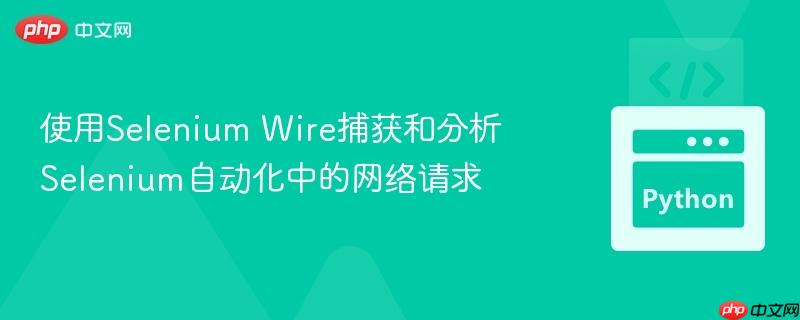
当使用Selenium进行Web自动化时,直接捕获前端与后端之间的API请求及其响应具有挑战性。本文将介绍如何利用`selenium-wire`库,它作为Selenium的扩展,能够轻松拦截、检查和分析浏览器发出的所有网络流量,包括API请求和JSON响应,从而弥补了标准Selenium在这一功能上的不足,为开发者提供了强大的网络监控能力。
引言:Selenium与网络请求捕获的挑战
Selenium作为一个强大的Web自动化测试工具,主要侧重于模拟用户与网页的交互,例如点击、输入、导航等。然而,在某些高级场景下,我们不仅需要模拟用户行为,还需要深入了解浏览器与服务器之间的数据交换,特别是前端通过JavaScript发起的异步API请求及其返回的JSON数据。
标准Selenium本身并不直接提供一套便捷的API来监听和捕获这些底层的网络请求。虽然可以通过WebDriver的开发者工具协议(CDP)接口或解析性能日志来间接获取部分信息,但这些方法通常较为复杂,且需要对浏览器内部机制有较深的理解。例如,尝试通过driver.get_log("performance")获取日志并解析Network.responseReceived事件,虽然可行,但代码实现起来往往冗长且维护成本较高。
面对“点击页面元素后,获取其触发的后端API请求及其JSON响应”这类需求时,我们需要一个更直接、更专业的解决方案。
解决方案:引入Selenium Wire
selenium-wire是selenium的一个强大扩展,它通过在WebDriver和浏览器之间设置一个代理,透明地拦截所有网络流量。这意味着开发者可以轻松地访问、检查甚至修改浏览器发出的每一个HTTP/HTTPS请求和接收到的每一个响应。
相比于直接使用CDP命令或解析性能日志,selenium-wire的优势在于:
- 简洁性: 提供直观的API来访问请求和响应对象。
- 全面性: 捕获所有类型的网络流量,包括XHR、Fetch、图片、CSS、JS等。
- 易用性: 无需复杂的浏览器内部知识,即可快速上手。
安装与配置
首先,你需要通过pip安装selenium-wire库:
pip install selenium-wire
安装完成后,你就可以像使用标准Selenium WebDriver一样,导入并初始化seleniumwire.webdriver。
from seleniumwire import webdriver
import json
import time
# 配置WebDriver选项,例如无头模式
options = webdriver.ChromeOptions()
options.add_argument('--headless') # 可选:在无头模式下运行
options.add_argument('--disable-gpu') # 禁用GPU加速,有时在无头模式下需要
# 初始化Selenium Wire WebDriver
# 默认情况下,Selenium Wire 会为每个请求和响应存储完整的body。
# 如果内存成为问题,可以配置为不存储body,或只存储特定请求的body。
# driver = webdriver.Chrome(options=options, seleniumwire_options={'disable_capture': True})
driver = webdriver.Chrome(options=options)捕获与分析网络请求
selenium-wire初始化后,所有通过该WebDriver实例发出的网络请求都会被自动捕获并存储在driver.requests列表中。每个元素都是一个Request对象,包含了请求和响应的详细信息。
实战示例:点击元素并获取API响应
假设我们有一个网页,其中包含一个按钮,点击该按钮会触发一个API请求并返回JSON数据。我们的目标是点击按钮,然后捕获这个API请求并解析其JSON响应。
from seleniumwire import webdriver
from selenium.webdriver.common.by import By
from selenium.webdriver.support.ui import WebDriverWait
from selenium.webdriver.support import expected_conditions as EC
import json
import time
# 1. 初始化Selenium Wire WebDriver
options = webdriver.ChromeOptions()
# options.add_argument('--headless') # 根据需要启用无头模式
options.add_argument('--disable-gpu')
driver = webdriver.Chrome(options=options)
try:
# 2. 导航到目标网页
# 替换为你的目标URL,这里使用一个示例
driver.get("https://www.example.com/some_dynamic_page")
print("已导航到页面。")
# 模拟页面加载和元素出现
# 假设页面上有一个ID为 'dataButton' 的按钮
# 你可能需要等待元素可点击
wait = WebDriverWait(driver, 10)
data_button = wait.until(EC.element_to_be_clickable((By.ID, "dataButton")))
# 3. 清空之前的请求记录,确保只捕获点击后的请求
driver.delete_all_requests()
print("已清空所有历史请求。")
# 4. 执行页面交互,触发API请求
data_button.click()
print("已点击按钮,等待API请求...")
# 5. 等待一段时间,让API请求完成并被捕获
# 或者使用更智能的等待方式,例如等待某个特定的API请求出现
time.sleep(5) # 简单等待5秒,实际应用中应更精确地等待
# 6. 遍历捕获到的请求,定位目标API
target_api_url_part = '/api/get_data' # 目标API的URL片段
found_api_response = None
for request in driver.requests:
if request.url.endswith(target_api_url_part) and request.response:
print(f"捕获到目标API请求: {request.url}")
print(f"请求方法: {request.method}")
print(f"响应状态码: {request.response.status_code}")
# 尝试获取并解析JSON响应体
try:
# request.response.body 是字节流,需要解码
response_body = request.response.body.decode('utf-8')
json_data = json.loads(response_body)
found_api_response = json_data
print("API响应数据:")
print(json.dumps(json_data, indent=2, ensure_ascii=False))
break # 找到目标后即可退出循环
except json.JSONDecodeError:
print("响应体不是有效的JSON格式。")
print(f"原始响应体: {response_body[:200]}...") # 打印部分原始响应体
except Exception as e:
print(f"处理响应时发生错误: {e}")
if not found_api_response:
print(f"未找到包含 '{target_api_url_part}' 的API请求或其响应。")
# 7. 对获取到的数据进行后续处理
if found_api_response:
print("\n成功获取并解析API数据,可以进行进一步处理。")
# 例如:assert found_api_response['status'] == 'success'
# 或者提取特定字段:data_items = found_api_response.get('items', [])
except Exception as e:
print(f"发生错误: {e}")
finally:
# 8. 关闭浏览器
driver.quit()
print("浏览器已关闭。")代码解析:
- 初始化: 使用seleniumwire.webdriver.Chrome()初始化WebDriver。
- 导航与交互: 导航到目标URL,并通过WebDriverWait确保按钮可点击,然后执行点击操作。
- 清空请求: 在执行关键操作前调用driver.delete_all_requests()是一个好习惯,它可以清除之前捕获的所有请求,确保我们只关注操作后新产生的请求,避免混淆。
- 遍历请求: driver.requests是一个列表,包含了所有被捕获的请求对象。我们可以遍历这个列表,通过request.url、request.method、request.response.status_code等属性来筛选出我们感兴趣的API请求。
- 获取响应体: request.response.body包含了响应的原始字节数据。对于JSON响应,我们需要先使用.decode('utf-8')将其解码为字符串,然后使用json.loads()解析为Python字典。
高级过滤
selenium-wire还提供了更灵活的过滤机制。你可以通过driver.wait_for_request()方法等待特定的请求,这比简单的time.sleep()更高效和准确。
# 等待一个URL包含特定字符串的请求
request = driver.wait_for_request('/api/get_data', timeout=10)
if request.response:
print(f"捕获到请求: {request.url}")
print(f"响应体: {request.response.body.decode('utf-8')}")你也可以在遍历时使用更复杂的条件:
for request in driver.requests:
if request.url.startswith('https://api.example.com/') and \
request.method == 'POST' and \
request.response.status_code == 200:
# 处理符合条件的请求
pass清空请求记录
为了避免内存占用过高,或者在不同测试步骤之间隔离请求,可以使用driver.delete_all_requests()来清空所有已捕获的请求记录。
注意事项与最佳实践
-
内存管理: selenium-wire默认会存储所有请求和响应的完整body。如果你的测试会产生大量的网络流量,这可能导致内存占用过高。你可以通过seleniumwire_options来配置:
driver = webdriver.Chrome( options=options, seleniumwire_options={'enable_compression': True, 'exclude_hosts': ['cdn.example.com']} ) # 或者在捕获后及时处理并清空 driver.delete_all_requests()对于不重要的请求,可以考虑不存储其body。
- 异步操作: 网页中的API请求通常是异步的。在执行操作后,需要给予足够的时间让网络请求完成。使用WebDriverWait结合EC.presence_of_element_located等待页面元素变化,或者使用driver.wait_for_request()等待特定请求,比简单的time.sleep()更为可靠。
- 错误处理: 在解析JSON响应时,务必使用try-except json.JSONDecodeError来处理非JSON格式的响应,提高代码的健壮性。
-
HTTPS证书: 在某些环境中,如果网站使用自签名证书,selenium-wire可能会遇到SSL证书错误。通常可以通过配置WebDriver选项来忽略SSL错误:
options.add_argument('--ignore-certificate-errors') - 代理冲突: selenium-wire通过设置内部代理工作。如果你的WebDriver配置了外部代理,可能会发生冲突。通常建议让selenium-wire自行管理代理。
总结
selenium-wire极大地扩展了Selenium的功能,使其能够轻松地拦截、检查和分析前端与后端之间的所有网络通信。无论是进行调试、数据抓取、API测试还是安全审计,selenium-wire都提供了一个强大而直观的工具集,弥补了标准Selenium在网络层监控方面的不足。通过本文介绍的方法,你可以有效地在Selenium自动化过程中捕获和利用API请求及其JSON响应,从而实现更高级、更深入的自动化测试和数据分析任务。






























